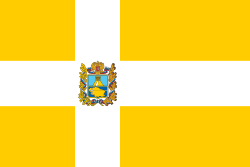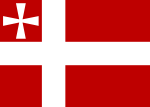Nordic Cross flag
The term Nordic Cross flag describes certain flags bearing the design of the so-called Nordic or Scandinavian cross, a cross symbol in a rectangular field, with the center of the cross shifted towards the hoist.
All of the Nordic countries have adopted such flags in the modern period, and while the Scandinavian cross is named for its use in the national flags of the Scandinavian nations, the term is used universally by vexillologists, in reference not only to the flags of the Nordic countries.[1]
While the design originates as a Christian cross, and as such ultimately derives from 13th-century designs in use during the Crusades,[2][3][4] the characteristic shift of the center to the hoist side is early modern, first described the Danish civil ensign (Koffardiflaget) for merchant ships in a regulation of 11 June 1748, which specified the shift of the cross center towards the hoist as "the two first fields must be square in form and the two outer fields must be 6/4 lengths of those". The Danish design was adopted for the flags of Norway (civil ensign 1821) and Sweden (1906), both derived from a common ensign used during the Union between Sweden and Norway 1818–1844, Iceland (1915) and Finland (1917); some of the subdivisions of these countries used this as inspiration for their own flags. The Norwegian flag was the first Nordic cross flag with three colours. All Nordic flags may be flown as gonfalons as well.
Flags of the Nordic countries
Note that most of these flags are historical or have not been officially adopted and their use remains limited.
Some of the flags in this list do not have official status. Also, note that flag proportions may vary between the different flags and sometimes even between different versions of the same flag.
Denmark
Official flags:
-
.svg.png) State flag of Denmark (17th century)
State flag of Denmark (17th century) -
 Naval ensign of Denmark (17th century). Note the darker kraprød colour (1939).
Naval ensign of Denmark (17th century). Note the darker kraprød colour (1939). -
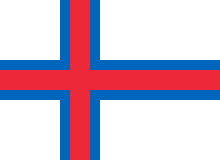 Flag of the Faroe Islands (1919)
Flag of the Faroe Islands (1919)
Unofficial flags:
-
 Unofficial flag of Bornholm (1970s)
Unofficial flag of Bornholm (1970s) -
 Another proposal for flag of Jutland, dating from 1972 (not in use)
Another proposal for flag of Jutland, dating from 1972 (not in use) -
 Proposal for a flag of Greenland, designed in 1984 by Sven Tito Achen. Rejected in favour of the non-Nordic-Cross flag.
Proposal for a flag of Greenland, designed in 1984 by Sven Tito Achen. Rejected in favour of the non-Nordic-Cross flag.
- ^ "Kunstavisen på internettet - Artikler". Archived from the original on 2 October 2006.
Finland
Official flags:
-
 Flag of Finland (1918)
Flag of Finland (1918) -
.svg.png) State flag of Finland (1978)
State flag of Finland (1978) -
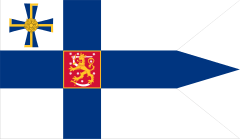 Flag of the President of Finland, with the Cross of Liberty in the canton (1978)
Flag of the President of Finland, with the Cross of Liberty in the canton (1978) -
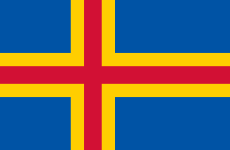 Flag of the Åland Islands (1954)
Flag of the Åland Islands (1954)
Private or unofficial flags:
-
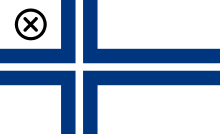 Yacht ensign of a Finnish yacht club. Club insignia goes in the canton (1861)
Yacht ensign of a Finnish yacht club. Club insignia goes in the canton (1861) -
 Unofficial flag representing the Swedish-speaking minority in Finland. To be flown along with the Finnish National Flag (1902)
Unofficial flag representing the Swedish-speaking minority in Finland. To be flown along with the Finnish National Flag (1902)
Iceland
-
.svg.png) State flag of Iceland
State flag of Iceland -
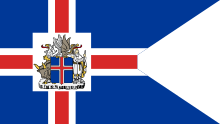 Flag of the President of Iceland
Flag of the President of Iceland -
 Flag of the Icelandic Customs Service
Flag of the Icelandic Customs Service -
 Former unofficial flag of Iceland (ca. 1900)
Former unofficial flag of Iceland (ca. 1900) -
 Proposal for flag of Iceland, designed in 1914 by Magnús Þórðarson
Proposal for flag of Iceland, designed in 1914 by Magnús Þórðarson
Norway
-
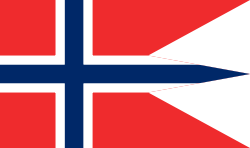 Naval ensign of Norway since 1905, civilian state flag since 1899.
Naval ensign of Norway since 1905, civilian state flag since 1899. -
.svg.png) Former flag of Norway (1814-1821).
Former flag of Norway (1814-1821). -
.svg.png) The common naval ensign and war flag of Sweden and Norway from 1815 to 1844.
The common naval ensign and war flag of Sweden and Norway from 1815 to 1844. -
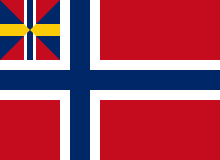 Merchant flag of Norway 1844-1898 with the union badge representing the union with Sweden.
Merchant flag of Norway 1844-1898 with the union badge representing the union with Sweden. -
.svg.png) Naval ensign and state flag of Norway 1844-1905.
Naval ensign and state flag of Norway 1844-1905. -
 Flag of Norwegian fascist party Nasjonal Samling 1933-1945.
Flag of Norwegian fascist party Nasjonal Samling 1933-1945.
Sweden
-
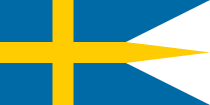 Naval ensign of Sweden
Naval ensign of Sweden -
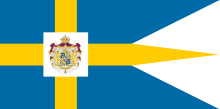 Royal standard of Sweden with the Greater coat of arms, used by the King of Sweden
Royal standard of Sweden with the Greater coat of arms, used by the King of Sweden -
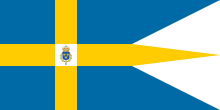 Royal standard of Sweden with the lesser coat of arms (the royal house using the greater coat of arms)
Royal standard of Sweden with the lesser coat of arms (the royal house using the greater coat of arms) -
.svg.png) Flag of Sweden 1844-1905 representing the union with Norway
Flag of Sweden 1844-1905 representing the union with Norway -
 Unofficial flag of the Finnish speaking minority in Sweden
Unofficial flag of the Finnish speaking minority in Sweden
Nordic cross flags outside of Scandinavia
Baltic
Estonia
-
 A proposal for the flag of Estonia (1919)
A proposal for the flag of Estonia (1919) -
 Proposed new flag of Estonia (2001)
Proposed new flag of Estonia (2001) -
 Proposed new flag of Estonia (2001)
Proposed new flag of Estonia (2001)
Latvia
-
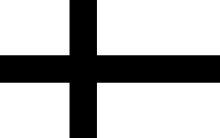 Flag of the short-lived Baltic Duchy (1918)
Flag of the short-lived Baltic Duchy (1918)
Germany
Nordic flags in Germany were historically used to allude to the nation's Germanic heritage and "Nordic" origins. Nordic flag designs very similar to Denmark's, Sweden's, and Norway's national flags were proposed as Germany's national flags in both 1919 and 1948, after World War I and World War II, respectively. Today, the Nordic cross is a feature in some city and district flags or coats of arms.
-
 Former North German Federal Navy Ensign (1867–71), Reichskriegsflagge
Former North German Federal Navy Ensign (1867–71), Reichskriegsflagge -
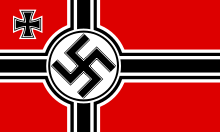 Former War Ensign of Nazi Germany (1938-1945), now forbidden in Germany
Former War Ensign of Nazi Germany (1938-1945), now forbidden in Germany -
.svg.png) Flag of the former Saar protectorate, Germany
Flag of the former Saar protectorate, Germany -
 Proposed National flag of Germany, circa 1919.
Proposed National flag of Germany, circa 1919. -
 Flag proposed by the conspirators of the July 20 plot against Hitler
Flag proposed by the conspirators of the July 20 plot against Hitler -
 A proposed flag for West Germany (1948)
A proposed flag for West Germany (1948)
- ^ In 1844, German nationalists in the two duchies of Holstein and Schleswig created a blue-white-red tricolour as a symbol for independence which began to see widespread use. In 1845, Denmark responded by outlawing all other flags than the Danish one shown here. This ban was enforced as long as Denmark controlled the two duchies (Holstein and Lauenburg: effectively until 1863, in Schleswig effectively until early 1864.) Use of the Danish flag was in turn outlawed by the secessionist administration that claimed both provinces 1848-1851.
Netherlands
-
 Flag of Aldtsjerk
Flag of Aldtsjerk -
 Flag of Bedum
Flag of Bedum -
 Flag of Gemert-Bakel
Flag of Gemert-Bakel -
 Flag of Gulpen-Wittem
Flag of Gulpen-Wittem -
 Flag of Hof van Twente
Flag of Hof van Twente -
 Flag of Houten
Flag of Houten -
 Flag of Kapelle
Flag of Kapelle -
 Flag of Lelystad
Flag of Lelystad -
 Flag of the Noordoostpolder
Flag of the Noordoostpolder -
 Flag of Skarsterlân
Flag of Skarsterlân -
 Flag of Tilburg
Flag of Tilburg -
 Flag of Utrechtse Heuvelrug
Flag of Utrechtse Heuvelrug -
 Flag of Vlagtwedde
Flag of Vlagtwedde -
 Flag of Werkendam
Flag of Werkendam -
 Flag of Weststellingwerf
Flag of Weststellingwerf -
 Flag of Wierden
Flag of Wierden
United Kingdom
A number of modern flag proposals for localities in the United Kingdom (primarily Scotland) are based on Nordic cross designs, intended to reflect the "Scandinavian heritage" introduced to the British Isles during the Viking Age.
-
 "cross of St Magnus, unofficial former "Flag of Orkney" (1990s)
"cross of St Magnus, unofficial former "Flag of Orkney" (1990s) -
 Unofficial flag of the island of South Uist (reported 2003)[1]
Unofficial flag of the island of South Uist (reported 2003)[1] -
Flag of Yorkshire West Riding (2013)[2]
- ^ "Not sure exactly what qualifies as a firmer sighting... but this flag is available for purchase and I can confirm that we have definitely despatched at least one of these flags to South Uist." (Charles Ashburner, 2 December 2003) crwflags.com
- ^ registered by the Flag Institute on 23 May 2013 as the winning entry in a competition
Brazil
-
 Flag of the City of São Paulo
Flag of the City of São Paulo -
 Flag of Alegre, Espírito Santo
Flag of Alegre, Espírito Santo -
 Flag of Areias, São Paulo State
Flag of Areias, São Paulo State -
 Flag of Borborema, São Paulo State
Flag of Borborema, São Paulo State -
 Flag of Carmo do Paranaíba, Minas Gerais
Flag of Carmo do Paranaíba, Minas Gerais -
 Flag of Chapadinha, Maranhão
Flag of Chapadinha, Maranhão -
 Flag of Colorado, Rio Grande do Sul
Flag of Colorado, Rio Grande do Sul -
 Flag of Domingos Martins, Espírito Santo
Flag of Domingos Martins, Espírito Santo -
 Flag of Escada, Pernambuco
Flag of Escada, Pernambuco -
 Flag of Frei Martinho, Paraíba
Flag of Frei Martinho, Paraíba -
 Flag of Grão Pará, Santa Catarina
Flag of Grão Pará, Santa Catarina -
 Flag of Guaíra, São Paulo State
Flag of Guaíra, São Paulo State -
 Flag of Itu, São Paulo State
Flag of Itu, São Paulo State -
 Flag of Jacupiranga, São Paulo State
Flag of Jacupiranga, São Paulo State -
 Flag of Lagoa Formosa, Minas Gerais
Flag of Lagoa Formosa, Minas Gerais -
.svg.png) Flag of Nova Era, Minas Gerais
Flag of Nova Era, Minas Gerais -
 Flag of Palotina, Pará
Flag of Palotina, Pará -
 Flag of Peritiba, Santa Catarina
Flag of Peritiba, Santa Catarina -
 Flag of Pirapora do Bom Jesus, São Paulo State
Flag of Pirapora do Bom Jesus, São Paulo State -
 Flag of Santo Antônio do Pinhal, São Paulo State
Flag of Santo Antônio do Pinhal, São Paulo State -
 Flag of Santo Cristo, Rio Grande do Sul
Flag of Santo Cristo, Rio Grande do Sul -
 Flag of Vinhedo, São Paulo State
Flag of Vinhedo, São Paulo State
United States
-
 Flag of Little Rock, Arkansas
Flag of Little Rock, Arkansas -
 Campaign Flag of Puerto Rican Independence Party
Campaign Flag of Puerto Rican Independence Party -
 Flag of Portland, Oregon
Flag of Portland, Oregon -
 Flag of Wilmington, Delaware
Flag of Wilmington, Delaware
Other
-
 Flag of Bleimor, a former Breton Scouting organization in France
Flag of Bleimor, a former Breton Scouting organization in France -
 Flag of Debarca Municipality, Macedonia
Flag of Debarca Municipality, Macedonia -
 Flag of Drugovo Municipality, Macedonia
Flag of Drugovo Municipality, Macedonia -
 Flag of the Georgian Orthodox Church
Flag of the Georgian Orthodox Church -
 Royal Standard of Greece (1863). Note: George I was also a prince of Denmark.
Royal Standard of Greece (1863). Note: George I was also a prince of Denmark. -
 Flag of Hernandarias, Paraguay.
Flag of Hernandarias, Paraguay. -
Proposed flag of South Island, New Zealand
-
.svg.png) Naval ensign of South Africa (1952–1981)
Naval ensign of South Africa (1952–1981) -
 Naval ensign of Tonga
Naval ensign of Tonga -
 Alternative flag of Tudela, Navarre, Spain
Alternative flag of Tudela, Navarre, Spain
Ethnic flags
-
 Unofficial flag of Ingrian people
Unofficial flag of Ingrian people -
 Flag of the Veps since 1992, designed by Vitaly Dobrynin. In 2000-2005 span used as the official flag of Vepsian autonomous region in Russian Karelia
Flag of the Veps since 1992, designed by Vitaly Dobrynin. In 2000-2005 span used as the official flag of Vepsian autonomous region in Russian Karelia -
 Unofficial flag of the Votes
Unofficial flag of the Votes -
 Former official flag of East Karelia, designed by Akseli Gallen-Kallela.
Former official flag of East Karelia, designed by Akseli Gallen-Kallela. -
 Unofficial flag of Frisia
Unofficial flag of Frisia -
 Flag of the Mi'kmaq people, Canada (horizontal version)
Flag of the Mi'kmaq people, Canada (horizontal version) -
 flag used by the Mouvement Normand
flag used by the Mouvement Normand -
 The "Vinnland flag", used by American band Type O Negative
The "Vinnland flag", used by American band Type O Negative
See also
- Flags of Central America
- Flag of Gran Colombia
- Pan-African colours
- Pan-Arab colours
- Pan-Slavic colours
- Southern Cross Flag
- Union Flag
- Tricolour
References
- ↑ EnchantedLearning.com; Historical flags of the world: The scandinavian cross; Eric Inglefield: "Fahnen und Flaggen" (translated to German by Dagmar Hahn), Delphin Verlag, Munich 1986, p.16
- ↑ Jeroen Temperman. State Religion Relationships and Human Rights Law: Towards a Right to Religiously Neutral Governance. Martinus Nijhoff Publishers. p. 88. Retrieved 2007-12-31.
Many predominantly Christian states show a cross, symbolising Christainity, on their national flag. The so-called Scandinavian crosses or Nordic crosses on the flags of the Nordic countries–Denmark, Finland, Iceland, Norway and Sweden–also represent Christianity.
- ↑ Carol A. Foley. The Australian Flag: Colonial Relic or Contemporary Icon. William Gaunt & Sons. Retrieved 2007-12-31.
The Christian cross, for instance, is one of the oldest and most widely used symbols in the world, and many European countries, such as the United Kingdom, Norway, Sweden, Finland, Denmark, Iceland, Greece and Switzerland, adopted and currently retain the Christian cross on their national flags.
- ↑ Andrew Evans. Iceland. Bradt. Retrieved 2007-12-31.
Legend states that a red cloth with the white cross simply fell from the sky in the middle of the 13th-century Battle of Valdemar, after which the Danes were victorious. As a badge of divine right, Denmark flew its cross in the other Scandinavian countries it ruled and as each nation gained independence, they incorporated the Christian symbol.
- Znamierowski, Alfred (2002). The world encyclopedia of flags : The definitive guide to international flags, banners, standards and ensigns. London: Hermes House. pp. 103 and 134. ISBN 1-84309-042-2.
External links
| Wikimedia Commons has media related to Nordic Cross flags. |
| ||||||||||||||||||||||||||||||||||||||||||
| ||||||||||||||||
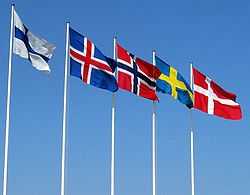


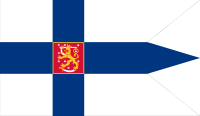



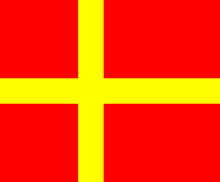





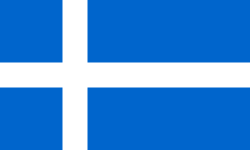
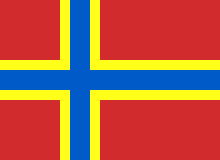


.svg.png)



